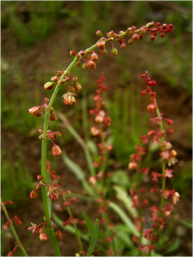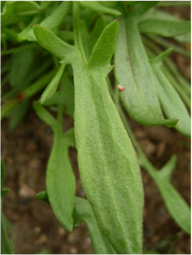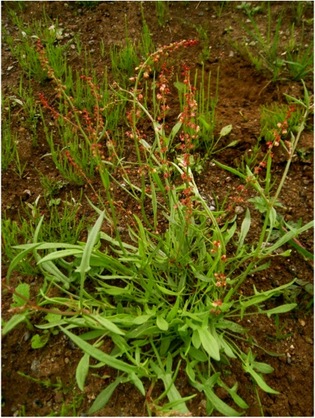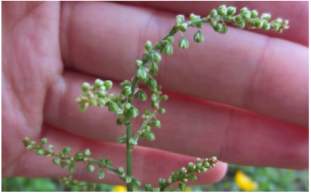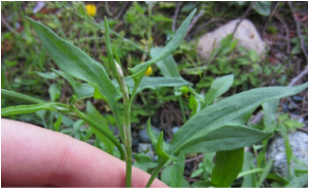Sheep sorrel, sour weed • Rumex acetosella
{Sorrel = sour, from French surelle and Lower German suur}
Photos of sheeps sorrel clockwise from top left: red flowers by Kelsey Collins, sorrel plant by Kelsey Collins, leaves by Kelsey Collins, buds by Kate Adams, stem tip by Kate Adams, and sorrel plant by Kelsey Collins.
Identification
Sheep sorrel is recognizable by its deep red flowers which bloom from May through September. The flowers top light-green smooth stems which grow in clusters and get 15-50 cm tall. It has broad, long, arrowhead-shaped leaves which grow densely at the base and reduce in size and frequency up the stem. Sheep sorrel is a perennial flowering plant which spreads via rhizomes (underground horizontal stems) and is often found in dense colonies. When soil is broken up the rhizome fragments each re-sprout resulting in quick and concentrated regrowth. Sheep sorrel is considered an invasive weed which out-competes many native species.
Habitat & Range
Sheep sorrel quickly invades recently disturbed sites such as clearings, tilled soil, burn sites, and roadsides. It is commonly found in meadows, grasslands, along forest edges and is especially prominent close to human settlements. Sheep's sorrel is common in southern BC at low to middle elevations and is rarer northwards. This tremendously invasive plant is found in all Canadian provinces, throughout all of the United States, and is quickly spreading through the rest of the Americas, Europe, and Asia.
Interesting Info
The leaves of sheep sorrel contain oxalic acid which gives the plant a distinct sour taste which many find pleasant. Although the leaves are a good source of vitamin C, do not overindulge! Oxalic acid interferes with calcium metabolism and results in build up of calcium oxalate crystals, which are a major component of kidney stones.
Sheep sorrel is recognizable by its deep red flowers which bloom from May through September. The flowers top light-green smooth stems which grow in clusters and get 15-50 cm tall. It has broad, long, arrowhead-shaped leaves which grow densely at the base and reduce in size and frequency up the stem. Sheep sorrel is a perennial flowering plant which spreads via rhizomes (underground horizontal stems) and is often found in dense colonies. When soil is broken up the rhizome fragments each re-sprout resulting in quick and concentrated regrowth. Sheep sorrel is considered an invasive weed which out-competes many native species.
Habitat & Range
Sheep sorrel quickly invades recently disturbed sites such as clearings, tilled soil, burn sites, and roadsides. It is commonly found in meadows, grasslands, along forest edges and is especially prominent close to human settlements. Sheep's sorrel is common in southern BC at low to middle elevations and is rarer northwards. This tremendously invasive plant is found in all Canadian provinces, throughout all of the United States, and is quickly spreading through the rest of the Americas, Europe, and Asia.
Interesting Info
The leaves of sheep sorrel contain oxalic acid which gives the plant a distinct sour taste which many find pleasant. Although the leaves are a good source of vitamin C, do not overindulge! Oxalic acid interferes with calcium metabolism and results in build up of calcium oxalate crystals, which are a major component of kidney stones.
References
Pojar, J. and MacKinnon, A. (2005). Plants of Coastal British Columbia, Revised. Vancouver, BC: Lone Pine Publishing. P. 129.
Rumex acetosella L. sheep sorrel (common sheep sorrel) Polygonaceae (Buckwheat family). In Klinkenberg, Brian. (Editor) 2014. E-Flora BC: Electronic Atlas of the Plants of British Columbia. Lab for Advanced Spatial Analysis, Department of Geography, University of British Columbia, Vancouver. Accessed 12/16/2014.
Sheep's sorrell. Invasive species in Garry Oak and associated ecosystems in British Columbia. Garry Oak Ecosystem Recovery Team (GOERT). Accessed 12/16/2014.
Authors and editors of page
Paige Whitehead and Brian Starzomski (2014).
Pojar, J. and MacKinnon, A. (2005). Plants of Coastal British Columbia, Revised. Vancouver, BC: Lone Pine Publishing. P. 129.
Rumex acetosella L. sheep sorrel (common sheep sorrel) Polygonaceae (Buckwheat family). In Klinkenberg, Brian. (Editor) 2014. E-Flora BC: Electronic Atlas of the Plants of British Columbia. Lab for Advanced Spatial Analysis, Department of Geography, University of British Columbia, Vancouver. Accessed 12/16/2014.
Sheep's sorrell. Invasive species in Garry Oak and associated ecosystems in British Columbia. Garry Oak Ecosystem Recovery Team (GOERT). Accessed 12/16/2014.
Authors and editors of page
Paige Whitehead and Brian Starzomski (2014).
